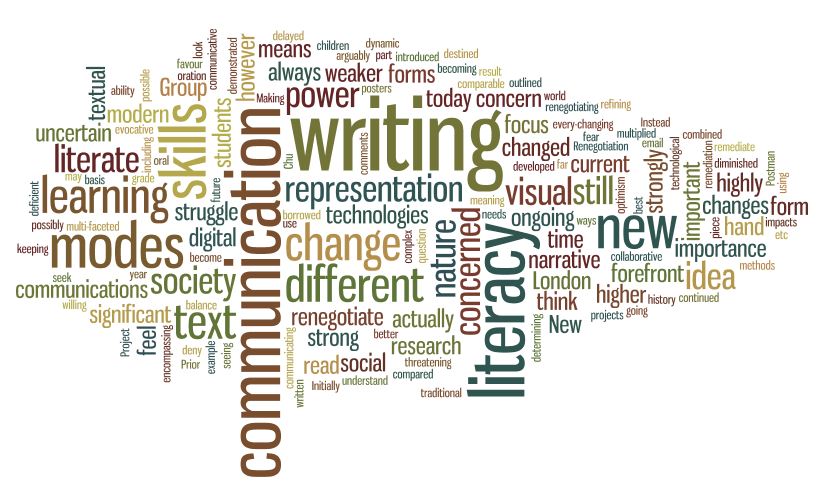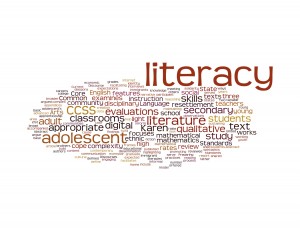In reflecting on this course from beginning to end, I find myself with a much better picture and time-line of the process from oral language to the forms of text we use today. Ong (1982) wrote about oral cultures and their ability to preserve knowledge without the ability to write, and how that increased the need to develop memorization skills, oral histories, and the importance of conversation and social speech. Early styles of writing were developed as cultures had the need to express their thoughts and ideas in ways that would preserve their knowledge, which in turn progressively improved with the invention of papyrus and writing tools.
Moving the calendar ahead to present time we can see the larger picture of the journey from orality to literacy, and to the multi-literacies we recognize today as part of the more commonly recognized 21st Century Learning Skills. As we explored the multi-literacies described by the New London Group (1996), I can see the importance of re-defining writing and literacy for the 21st century students I am teaching.
Throughout this course I have had the opportunity to discover how these multi-literacies can be implemented and integrated into the curriculum I teach every day. Using the course weblog to publish my work, and to see the work and ideas published by my peers has given me the opportunity to express my learning along side of my peers. The blog also provided me with a chance to reflect on my work based on the responses and perspectives posted by my readers. I found the final project by Grant Sorensen and Andrew Lemon, Media Representations of the Attacks on the World Trade Center, inspired me to reflect on the ‘image’, and how it can be used not only to describe an event or moment in time, but can also be purposefully used to evoke an intentional literary response.
I explored several different web 2.0 tools such as, Toondoo, slidebomb, smilebox, among a few others, as I tried to find ways to express my work in other media. I found it most useful to see how others used web 2.0 tools to present their work, as it inspired me to venture a little further to try out new tools. My group presented our final project with Prezi, and I find myself still searching out resources for ways to make future use of it smoother and less tedious.
Over all, my discoveries in this course have lead me to delve deeper into finding creative ways to inspire my students to write for their audiences. My students need to be prepared to write and communicate in very different ways and for very different purposes than when I was their age. I realize that as technology changes, and our global community grows, the needs of my students’ will change. My challenge will be to model and inspire them to be communicators who can respond to, and evoke response from, their global audience.
Chenoa Dirks
References
Ong, Walter. (1982). Orality and literacy: The technologizing of the word. London: Methuen.
New London Group. (1996). A pedagogy of multiliteracies: Designing social futures. Educational Review, 66(1), 60-92






Making Connections: Reading the Cloud
Well, the first time I published this post it came out blank, and I always have a hard time producing a reproduction of a previously written and lost work, but I’ll try.
What does the title of this post say to you? To me, it provides a thread to connect the ideas we have explored throughout the duration of this course. It’s my last post of the course, so please allow me the metaphorical lenience to explore how reading the clouds might provide a way to interpret the vast shifts in communication that have occurred throughout history.
Beginning our class with the establishment of oral versus literate cultures through the tenuous theories of Ong provided a starting point to consider the impact of technology on culture. Through Ong’s lens, expressions such as “head in the clouds” are residual pieces of our oral culture histories, providing easily referenced forms of meaning where a lack of written records created a reliance on epithets for social memory. It was even suggested that the cognitive structure of an oral culture was different from a literate one in that information and communication in an oral culture was experiential, creating a far stronger bond between an individual and their environment.
However, as further readings began to soften the distinction between orality and literacy, a theory of multiliteracies began to emerge that postulated for a resurgance of orality in our digital era. Framed through the analysis of the history of printing technologies, the determinism of our cultural forms became a contested topic between cultural and technological determinism camps.
Regardless of your position on the topic above, I think it is clear that our culture and the technologies that it uses are always in flux, and our perception of our reality is shaped by the combination of both. Returning to my metaphorical tool-of-a-title, it is apparent what types of implications this may lead to. When I say reading the clouds, what stands out to me is that as a kid I was certain that no one else could see what I saw in the clouds. Whether it was an elephant or a submarine, by the time I had explained to a friend where to look, the atmospheric winds had turned it into something different. Our observations were subjective, our reality was our own interpretation of our experiences and those of others. However, a modern usage of “reading the cloud” conjurs thoughts of infinite information, completely accessible and objective. Although we all know through our relationships that our reality is still completely subjective and uniquely our own, the notion that the objective truth is only a google search away is slowly creeping into our psyche, and this will certainly impact future generations.
I work in adult literacy, and so I thought I would make a word cloud using an RSS feed from the Journal of Adolescent and Adult Literacy. What do you see? I see a submarine.